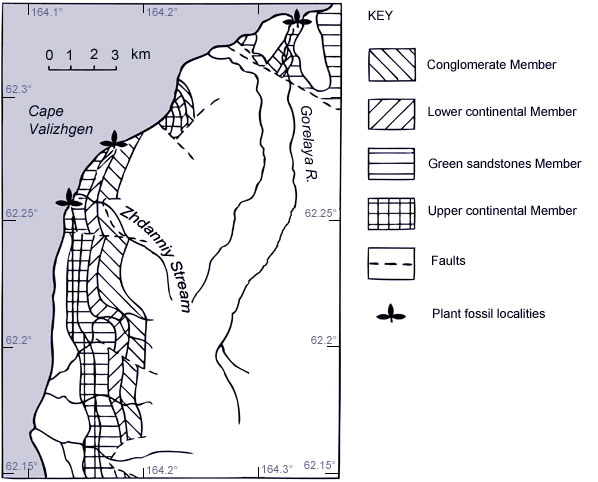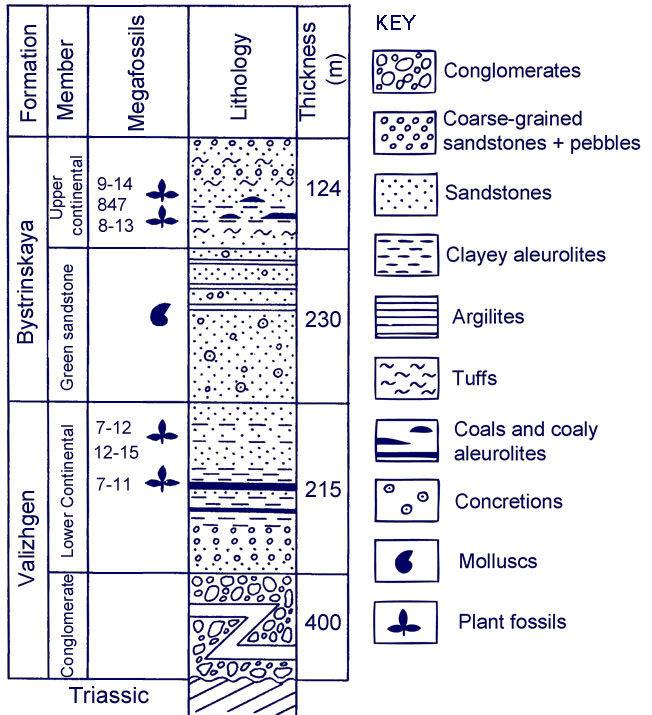Cape Valizhgen
| Cape Konglomeratoviy | Cape Valizhgen | Yelistratov Peninsula | Penzhina Floral Phase | Kaivayam Floral Phase | NE Russia Map |
|---|---|---|---|---|---|
| Northwest Kamchatka Geology | Fossil Images | ||||
Taphofloras of Cape ValizhgenIn the vicinity of the Valizhgen Cape the Valizhgen and Bystrinskaya Formations have very different lithologic composition (see panel lower right). Here plant fossils have also been collected from several plant-bearing beds in the uninterrupted section of both the formations. The Valizhgen and Upper Bystrinskaya taphofloras are distinguished here (Herman, 1988a, 1991, 2011). The Valizhgen TaphofloraThe Valizhgen Taphoflora comes from the Lower continental Member (upper part of the Valizhgen Formation) on the Valizhgen Cape (see panel lower right). The coastline of the Penzhina Bay near the mouth of the Gorelaya River as well as to the south of Cape Valizhgen exposes continental coal-bearing rocks containing plant fossils. The Valizhgen taphoflora is dominated by Macclintockia crenata with abundant Nilssonia aff. alaskana, Ginkgo ex gr. adiantoides, Sequoia aff. reichenbachii, etc. Ferns are rare featuring some representatives of the genus Hausmannia. Large-leaved platanoid plants - the group characterizing the taphofloras considered above - are reported to be entirely lacking here. Platanoids are represented in the Valizhgen taphoflora by a few specimens of the only species Ettingshausenia cf. prisca possessing a small or medium-sized leaf lamina. The Kayvayam and Valizhgen taphofloras, which come from the upper half of the Valizhgen Formation exposed at Cape Konglomeratoviy and Cape Valizhgen respectively, are similar in that they both have some common species (Magnoliaephyllum magnificum, Ettingshausenia prisca, "Zizyphus" smilacifolia, etc.). However, such features as overall systematic composition, predominance of Macclintockia, low frequencies of platanoid plants, the presence of cycadophytes, and the appearance of the genera Hollickia, Rhamnites, and Grewiopsis make the Valizhgen taphoflora markedly different from the Penzhina and Kayvayam taphofloras. It does, however, display some similarities with the following Upper Bystrinskaya taphoflora. The Upper Bystrinskaya TaphofloraThe Upper Bystrinskaya Taphoflora comes from the Upper continental Member (upper part of the Bystrinskaya Formation) on the Valizhgen Cape (see panel right). Predominant plants here include Barykovia tchucotica and Macclintockia ochotica. Large-leaved platanoid plants are represented by specimens of Paraprotophyllum ignatianum and Arthollia (?) sp., Viburniphyllum (three species) and "Zizyphus" kujiensis have been encountered in high frequences. Also quite common are Celastrinites wardii, Rhamnites septentrionalis, Trochodendroides richardsonii, Quereuxia angulata and representatives of the genera Nilssonia, Cephalitaxopsis, Grewiopsis, "Vitis", and Cissites. Ferns are rare. |
Map of the Cape Valizhgen area, N.W. Kamtchatka. Rock divisions after Pergament (1961) with supplements. For lithology and stratigraphy see the chart below.
Lithology and stratigraphy of Cretaceous rocks in the vicinity of Cape Valizhgen from Pergament (1961) with supplements.
|
|
The Upper Bystrinskaya and Valizhgen taphofloras are similar in that they both have abundant Macclintockia and an insignificant involvement of platanoid plants. However, the second dominant species of the Upper Bystrinskaya taphoflora, i.e. Barykovia tchucotica, has not been reported from the Valizhgen complex. These taphofloras are also brought together by the presence of common genera Nilssonia, Grewiopsis, "Zizyphus", Rhamnites, Viburniphyllum, but species differ between the taphofloras. Such affinity between the Valizhgen and Upper Bystrinskaya taphofloras together with their dissimilarity to the Kayvayam complex suggests the Valizhgen and Kayvayam taphofloras are not coeval, although both originate from the upper half of the Valizhgen Formation. The Valizhgen taphoflora is probably younger than the Kayvayam taphoflora. Based on the stratigraphic position of the Valizhgen complex plant-bearing rocks it is likely that the Valizhgen taphoflora is of early Santonian age. Hence it follows that the strata enclosing the Valizhgen taphoflora correlate with the uppermost part of the Valizhgen Formation on the Konglomeratovyi Cape which contains no plant fossils and/or with the lowermost beds of the Bystrinskaya Formation at Cape Konglomeratoviy, i.e. the bulk of the Valizhgen Formation on the Valizhgen Cape is somewhat younger than that on the Konglomeratovyi Cape due to its inclusion of the younger (Lower Santonian ?) deposits. The age of the Upper Bystrinskaya taphoflora is determined as early Campanian based on correlations with marine deposits (see the stratigraphy and palaeontology of Northwest Kamchatka). It is not impossible, however, that the plant-bearing strata may be extend into the uppermost Upper Santonian and/or lowermost Upper Campanian. |
||


